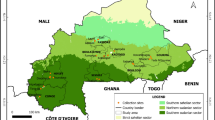Summary
Naturally established individuals of Plantago lanceolata with the inflorescence disease caused by Fusarium moniliforme var. subglutinans had more inflorescences and were more likely to be male-sterile than healthy plants. Half-sib families planted in the field varied in the percentage of diseased plants, the number of inflorescences per plant, the incidence of male-sterility, and the pattern of inflorescence phenology. The rankings of families with respect to disease incidence was, however, not simply related to their reproductive phenotypes. Plants derived from field genotypes with a history of disease were slightly more likely to become diseased than plants derived from healthy genotypes. Inflorescence infection was more severe on plants derived from genotypes with a known history of disease. Since the fungus reduces seed production in the plants it infects, differential incidence of disease based on plant phenotype and genotype may have ecological and evolutionary consequences for the host population.
Similar content being viewed by others
References
Alexander HM (1982) Demography of ad intraspecific variation in Plantago lanceolata in relation to infection by the fungus Fusarium moniliforme var. subglutinans. Dissertation. Duke University, Durham, North Carolina
Alexander HM (1984) Spatial patterns of disease induced by Fusarium moniliforme var. subglutinans in a population of Plantago lanceolata. Oecologia (Berlin) 62:141–143
Burdon JJ, Shattock RC (1980) Disease in plant communities. Applied Biology 5:145–219
Comstock JC, Martinson CA, Gengenbach BG (1973) Host specificity of a toxin from Phyllosticta maydis for Texas cytoplasmically male-sterile maize. Phytopathology 63:1357–1361
Day PR (1974) Genetics of host-parasite interaction. W.H. Freeman and Co., San Francisco, California
Deverall BJ (1977) Defence mechanisms of plants. Cambridge University Press, Cambridge, England
Fowler N, Antonovics J (1981) Competition and coexistence in a North Carolina grassland. I. Patterns in undisturbed vegetation. J Ecol 69:825–841
Gibbs A, Harrison B (1976) Plant virology: the principles. Edward Arnold, London, England
Hooker, AL, Saxena KMS (1971) Genetics of disease resistance in plants. Ann Rev Genetics 5:407–424
Horsfall JG, Cowling EB (eds) (1978) Plant disease: an advanced treatise. Volume III. How plants suffer from disease. Academic Press. New York
Johnson VA, Schmidt JW (1968) Hybrid wheat. Adv Agron 20:199–233
Leppik EE (1970) Gene centers of plants as sources of disease resistance. Ann Rev Phytopathol 8:323–344
Montes RA, Christensen NL (1979) Nitrification and succession in the piedmont of North Carolina. Forest Sci 25:287–297
Primack RB (1976) The evolutionary basis of population dynamics in the genus Plantago. Dissertation. Duke University, Durham, North Carolina
Puranik SB, Mathre DE (1971) Biology and control of ergot on male sterile wheat and barley. Phytopathology 61:1075–1080
Ross MD (1969) Digenic inheritance of male sterility in Plantago lanceolata. Can J Genet Cytol 11:739–744
Roughgarden J (1979) Theory of population genetics and evolutionary ecology: an introduction. Macmillan Publishing Co., New York
Sokal RR, Rohlf FJ (1981) Biometry. W.H. Freeman and Co., San Francisco, California
Van Damme JMM (1983) On gynodioecy in Plantago lanceolata. University of Groningen, The Netherlands
Van Damme JMM, Van Delden W (1982) Gynodiecy in Plantago lanceolata L. I. Polymorphism for plasmon type. Heredity 49:303–318
Wood RKS (1967) Physiological plant pathology. Blackwell Scientific Publications, Oxford, England
Wu L, Antonovics J (1975) Experimental ecological genetics in Plantago. I. Induction of roots and shoots on leaves for large scale vegetative propagation and metal tolerance testing in P. lanceolata. New Phytol 75:277–282
Zar JH (1974) Biostatistical analysis. Prentice-Hall, Inc., Englewood Cliffs, New Jersey
Zimmer DE, Rehder D (1976) Rust resistance of wild Helianthus species of the North Central United States. Phytopathology 66:208–211
Author information
Authors and Affiliations
Rights and permissions
About this article
Cite this article
Alexander, H.M., Antonovics, J. & Rausher, M.D. Relationship of phenotypic and genetic variation in Plantago lanceolata to disease caused by Fusarium moniliforme var. subglutinans . Oecologia 65, 89–93 (1984). https://doi.org/10.1007/BF00384468
Received:
Issue Date:
DOI: https://doi.org/10.1007/BF00384468




